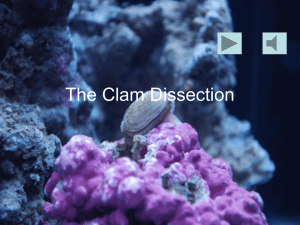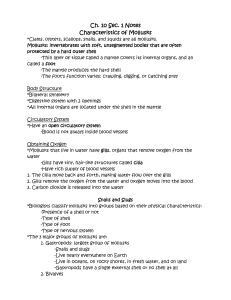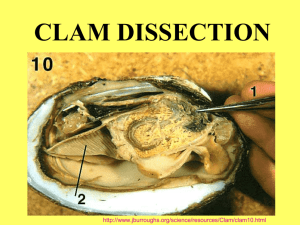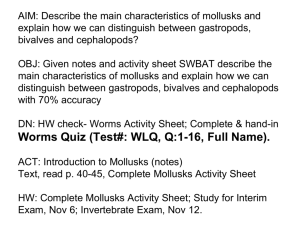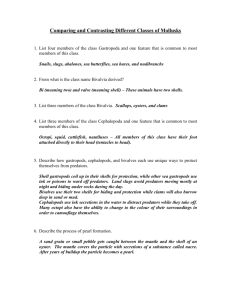Mollusks Review - local.brookings.k12.sd.us
advertisement
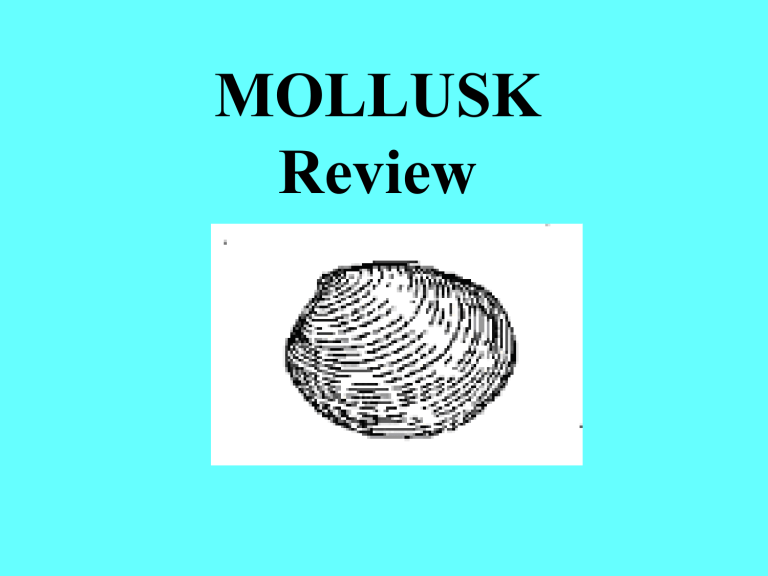
MOLLUSK Review Name one of the three classes of mollusks you learned about. Gastropods, cephalopods, Bivalves The free swimming ciliated larva found in most aquatic mollusks is Trochophore called a _________________ The space around the heart is called the _____________ pericardial space (cavity). In mollusks the heart and organs for digestion, excretion, and reproduction are found in this body region. Visceral mass The octopus, squid, and chambered nautilus belong to this group of Mollusks. cephalopods This bump on the dorsal surface of a clam near the hinge is umbo the _______ Pigment cells in the outer mantle layer in cephalopods that can change color for camouflage. chromatophores Identify the colored structures. Anterior & posterior adductor muscles The nervous system in a clam consists of _____________________________ 3 pairs of ganglia connected by 2 pairs of nerve cords Type of body cavity found in mollusks. No coelom pseudocoelom eucoelom eucoelom The powerful muscles that open and close a clam shell are the ___________ Adductor muscles (posterior and anterior) Identify the body system each organ belongs to: Excretory Kidney __________________ Reproductive Testes/ovary ____________________ Respiratory Gills ___________________ Digestive Digestive gland ___________________ Nervous Ganglia ____________________ Circulatory Heart ____________________ What keeps water moving over the gills in a clam? Cilia on gills move water A flexible tongue-like strip of tissue covered with tough, abrasive teeth that point backwards found in some mollusks. radula Compare Digestive and Nitrogen waste DIGESTIVE WASTE NITROGEN WASTE Made where? In digestive tract By body cells Comes from? Left over from undigested food Removed by what body system? Leaves body as? Digestive Feces breakdown of proteins during metabolism Excretory ammonia, urea, OR uric acid This structure is the _____________ intestine Only cephalopod with a shell Chambered nautilus Name the group of mollusks that does NOT have a radula. bivalves Layer of epidermis lining the shell of a clam mantle #2 #1 #3 #2 = ________________________ Anterior adductor muscle gills #3 = _______________________ The process during larval development in which the visceral mass in gastropods twists around 180º bringing the mantle cavity, gills, and anus to the front of the animal. torsion open circulatory system. Clams have a(n)__________ Open Closed This part of the clam secretes the shell. mantle bilateral Mollusks have _________ symmetry. None radial bilateral Fertilization in clams is __________ both internal external both Depends on speciesin freshwater clams its usually internal in marine (ocean) clams its external Identify this structure heart The circulatory fluid (blood) in a mollusk is called _______________ hemolymph Respiratory organ in clams. gills The flaps that wave to move food up toward the mouth are called palps ___________________ The organ that passes through the pericardial cavity and lies under the heart is the __________________ intestine The space between the mantle and the visceral mass. Mantle cavity Which group of mollusks does NOT have a shell? Bivalves cephalopods cephalopods gastropods Organisms that stay in one place and don’t move around are called Sessile ___________________ Tell an advantage of having a coelom compared to a pseudocoelom. 1. Muscles of body wall are separate from those of gut. (Can move and digest at same time) 2. Coelom provides space for circulatory system to transport blood 3. Provides a space for organs invertebrates Mollusks are _______________ vertebrates invertebrates This blue structure secretes the shell. mantle Which group of mollusks is mainly sessile? Bivalves gastropods cephalopods bivalves T or F Most clams are hermaphrodites like earthworms. False; most clams have separate sexes Calcium carbonate in a mollusk’s ________________ shell makes it hard. An organism with a true coelom is eucoelomate called a ______________. Identify this structure. foot Clams and oysters belong to this group of mollusks. Bivalves Bivalves gastropods cephalopods This structure starts digestion and grinds food. stomach Cephalopods are the only mollusks with a ___________ circulatory system. closed open closed Fertilization in cephalopods is internal external Internal; Males use a specialized tentacle to transfer packets of sperm to the mantle cavity of the female Only mollusk group that develops from egg to juvenile without becoming a trochophore larva. cephalopods Snails and slugs belong to this group of mollusks. bivalves cephalopods gastropods gastropods Name one of the functions of the gills in a clam. 1. Gas exchange (oxygen and carbon dioxide) 2. Trap food particles Anus This opening is the _________. Name part that belongs to each body system: kidney Excretory __________________ Digestive ____________________ Palps, Esophagus, stomach, digestive gland, intestine, anus Adductors, foot Muscular ___________________ Ganglia, nerve cords Nervous ___________________ Heart, hemolymph, hemocoel Circulatory ____________________ This is the Digestive gland ________________________. Another word that means shell is ___________ . valve Type of circulatory system in which blood is NOT enclosed in vessels open Tell one body part you might look for if you wanted to tell direction in a clam. UMBO- it’s on the dorsal side FOOT- triangle points to the anterior end PALPS- at anterior end SIPHONS- at posterior end Which group of mollusks has chromatophores that can change color to blend in with the surroundings? cephalopods Why does the surface of the gills have ridges? Increases surface area to absorb more oxygen & catch more food The excretory organ in a clam is the nephridia kidney kidney flame cells This is the Incurrent __________ siphon __________ This organ surrounds the stomach and makes digestive enzymes. Digestive gland How does a trochophore larva swim? Ring of cilia around middle help it move Body system that removes nitrogen waste from the body cells digestive nervous excretory respiratory excretory #1 #2 #1 = ________________________ foot mantle #2 = _______________________ In a clam the coelom mainly surrounds the heart and is called pericardial the______________ cavity. Organisms that strain food from the Filter feeders water like clams are called _________. predators filter feeders scavengers autotrophs These are located on the surface of the clam’s shell and can Growth rings help tell it’s age. This part of the clam is the ____________ foot Name a part of the nervous system in a clam Ganglia OR nerve cord This opening is located near the excurrent siphon so waste is washed away anus #2 #3 #1 #1 = ________________________ Posterior adductor muscle mantle #3 = _______________________ This is the ____________ Excurrent siphon ____________ Organ in a clam is where nutrients are absorbed. Digestive gland Most organisms in this class of mollusks have 1 shell (or none) gastropods PHYLUM that clams, octopus, slugs, and snails belong to MOLLUSCA OR Mollusk Tell one way the nervous system in a clam is like that of an earthworm Both have ganglia Both have a nerve cord (clam has 2 pairs) Tell one way the reproductive system in a clam is different from an earthworm Earthworms hermaphrodites direct development external fertilization Clams have 2 sexes (male & female) indirect development (larva) internal/external fertilization The 3 functions of the digestive gland are to __________________ Make digestive enzymes (bile) Finish digestion Absorb nutrients The excretory organ in a clam is the ______________ kidney This space you see when you opened your clam is called the ________________ mantle cavity Coelom pericardial space mantle cavity The intestine runs through the space shown and is covered by the _________ HEART HEART The function of the palps is to __________________ Move food to the mouth anterior The ____________ end of the clam is closest to the umbo. Anterior Posterior Identify the body part by its description: bump on dorsal side of shell ______________ umbo Edge of shell shortest distance from umbo ______________________ anterior Tissue that lies on top of tube running through pericardial space ___________________ heart Growth rings Lines on clam shell ___________________ Mantle Layer lining shell ____________________ The function of the gills is to __________________ Both A & B are correct A. remove oxygen from water B. filter food particles C. make digestive enzymes D. excrete nitrogen waste Clams belong in the Animalia ______________ Kingdom Mollusca (mollusks) Phylum ______________ Bivalvia (bivalves) Class ______________ Identify the function of each body part: Adductor muscles__________________ Open and close shell Collect and remove digestive waste intestine ____________________ Gills ___________________ Exchange gases & trap food digestive enzymes to break down Digestive gland Make ___________________ food; finish digestion; absorb nutrients Move food up from gills to mouth Palps ____________________ Pump hemolymph (blood) Heart ____________________ Makes shell Mantle ________________________ True OR False Clams show cephalization. FALSE No true head area- Ganglia/sense organs are spread out throughout body not concentrated in head Tube that connects the mouth and the stomach in a clam esophagus The excretory organ in clams is the __________________ kidney In Latin the name Mollusca means “soft body” ________________. soft body two shells filter feeder little rings Identify the body part by its description: looks like a piece spaghetti inside visceral mass __________________ intestine Greenish brown area in anterior end ____________________ Digestive gland White fans in front of gills palps ___________________ Long flat structure with ridges (stripes) that runs along side of clam ___________________ gills Type of symmetry seen in clams bilateral Clams, oysters, octopus, snails, and squid belong to the PHYLUM _______________ Mollusca Kind of circulatory system seen in an octopus: Closed open closed All other mollusks have an open system Invertebrates (no backbone) Mollusks are _______________ invertebrates vertebrates Clams show __________ indirect development They hatch as trochophore larvae and change into their adult form direct indirect In Latin the name Bivalvia means “2 shells” ________________. soft body two shells filter feeder little rings What causes oxygen and carbon dioxide to move into and out of a clam? Diffusion moves molecules from where there is a HIGH concentration to where there is a LOW concentration Why do gills have ridges? Increases surface area What is the disadvantage of an OPEN circulatory system? Less efficient way to transport nutrients and oxygen High and low oxygen blood mix Why is it a good plan for a clam to have its anus near the excurrent siphon? Washes away digestive waste TELL WHICH BODY SYSTEM EACH PART BELONGS TO respiratory gills __________________________ Ganglia _________________ nervous circulatory heart___________________ excretory kidney _________________ adductors ____________________ muscular digestive intestine ____________________ protostomes MOLLUSKS are _____________ protostomes deuterostomes Give an example of a mollusk that is a bivalve Clams, oysters, scallops Match the Mollusk with its CLASS BIVALVIA Clams, oysters, scallops ___________ Squid, octopus, CEPHALOPODA chambered nautilus ______________ Snails, slugs, conchs, GASTROPODA Nudibranchs ______________ With a few exceptions: 2 Bivalves have _____ shell(s) Most 1shell(s) Gastropods have _____ few 0 0 Cephalopods have ____ shell(s) (Except nautilus) Name 3 body systems that use the mantle cavity as an exit Digestive-anus releases feces here Excretory- Kidney releases urea here Reproductivesperm and eggs are released here (external) Or sperm and eggs join here and larva exits (internal) Respiratory also uses this spacegills are located here COMPARE: Earthworms Clams RESPIRATORY Breathe through skin gills CIRCULATORY Aortic arches closed heart open NERVOUS 1 pr cerebral ganglia 1 ventral nerve cord 3 pr ganglia 2 pr nerve cords COMPARE: Earthworms Clams true True; pericardial cavity Absorbs nutrients? intestine Digestive gland EXCRETORY nephridia kidney COELOM ? TELL 3 characteristics of ALL Mollusks eucoelomates invertebrates protostomes Soft bodies Bilateral symmetry trochophore larvae (if indirect) Name the colored structure: palps Give its function: Move food trapped on gills up to mouth Name the colored structure: mantle Give its function: Secrete shell Name the colored structure: foot Give its function: locomotion Name the colored structure: Visceral mass Give its function: Contains body organs Name the colored structure: heart Give its function: Pump hemolymph (blood) Name the colored structure: Pericardial cavity(space) This could also be called the _____________ coelom Name the colored structure: Digestive gland Give its functions: Make bile, finish digestion, absorb nutrients Name the colored structure: anus It is the exit opening for which Body system? digestive
